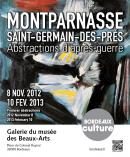EXHIBITION
Montparnasse / Saint-Germain-des-Prés. Post-war abstractions
The Montparnasse / Saint-Germain-des-Prés. Post-war abstractions exhibition intends to illustrate the post-war period by showing works of major artists of post-war abstraction: The first part shows two works from Roger Bissière - coming from the museum collections - the founder of non-figurative art in France. Jean Le Moal, Alfred Manessier and Geer Van Velde belong to this group.The second part is dedicated to three artists members of lyrical abstraction : Olivier Debré, Gérard Schneider and André Marfaing. The purpose of the exhibition aims to go well beyond this, however.the works chosen are not limited to the immediate post-war period or to the 1950s ; they punctuate the careers of these artists and show their evolution throughout the years that followed.
At the end of the 19th century, painters took great liberties with the academic tradition, both in terms of chromatics and in terms of form. This challenge to the rules that had governed art until that moment would lead to a genuine revolution in pictorial art: the dawn of abstract art.From 1910, Vassily Kandinsky (1866-1944) led the way in this new form of painting freed from all tendency towards illustration. He was followed, in 1912, by Piet Mondrian (1872-1944) who, through the use of geometrical figures, sought to provoke an emotion in the viewer. The next year, Kazimir Severinovich Malevich (1879-1935) pushed Mondrian’s theories to the extreme in order to create the famous work Black Square, and in 1918 completed White on White.
The Second World War would mark a significant break in the evolution of art. ‘Paris awoke and, with it, all the arts awoke. We read The Outsider by Albert Camus and went to see Huis Clos by Jean-Paul Sartre. Auguste Perret reconstructed Le Havre and Le Corbusier drew up plans for the “radiant city”, of which one “housing unit” would be built in Marseille. A first exhibition of abstract art was organised in a slightly obscure place, the Centre on Rue Cujas, in the Latin Quarter. New literature, new architecture, new painting, and new music too, with the Vingt Regards sur l’Enfant Jésus by Olivier Messiaen who returned from Germany, where he’d been a prisoner. And yet more new music, with the jazz be-bop of Charlie Parker and Dizzy Gillespie’ (Michel Ragon, Schneider, Angers, Expressions contemporaines, 1998, p6).
Kandinsky, Mondrian and Malevich had all been isolated in their respective countries. In liberated Paris, artists from all over the world came together: Russians, Germans, Americans, Chinese, Portuguese, Hungarians, Swiss and Dutch.These artists, who lived and worked in the same city, even in the same district – Montparnasse / Saint-Germain-des-Prés – met one another. And, because the differences between them opened the doors to a vast artistic diversity, Paris became the beacon of abstract art and acquired an aura that extended well beyond the borders of France. It was these artists, moreover, who would win the most important international awards.In 1945, the great geometric and lyrical abstract artists that we know today, their careers having been interrupted by the war, were generally unknown to art connoisseurs of the time. But a few women dared to show their works in their modest galleries: Colette Allendy, Lydia Conti, Denise René. They helped make these artists – so passionate about freedom, ready to dare anything – into international stars whose works are now displayed in museums all over the world.
COMMISSARIAT GÉNÉRAL
Marc Favreau
Conservateur en chef du patrimoine au musée des Beaux-Arts de Bordeaux.
COMMISSARIAT
Agnès Birot
Attachée de conservation au musée des Beaux-Arts de Bordeaux.
Dominique Beaufrère
Assistant de conservation au musée des Beaux-Arts de Bordeaux.
INFORMATIONS PRATIQUES
Galerie des Beaux-Arts
Place du Colonel Raynal
33 000 Bordeaux
Tél. : 33 (0)5 56 96 51 60
Fax : 33 (0)5 56 10 25 13
musba@mairie-bordeaux.fr
OUVERTURE
Le musée et la galerie sont ouverts tous les jours de 11h à 18h sauf les mardis et jours fériés.
ACCÉS
Tramway : ligne A ou B, arrêt Palais de Justice ou Hôtel de Ville.
Stationnement : parcs autos Mériadeck ou Saint-Christoly.
VISITES
Visites commentées de l’exposition tous les mercredis
et samedis à 16 heures
TARIFS
Tarif normal : 5 €. Tarif réduit : 2,5 €
Tarif des visites commentées : entrée+3 €
DIRECTION DE LA COMMUNICATION
MAIRIE DE BORDEAUX
Service presse mairie
Tél. : (33) 05 56 10 20 46







